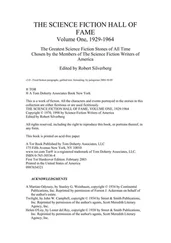Robert Silverberg - Hot Times in Magma City
Здесь есть возможность читать онлайн «Robert Silverberg - Hot Times in Magma City» весь текст электронной книги совершенно бесплатно (целиком полную версию без сокращений). В некоторых случаях можно слушать аудио, скачать через торрент в формате fb2 и присутствует краткое содержание. Год выпуска: 2014, ISBN: 2014, Издательство: Subterranean Press, Жанр: Фантастика и фэнтези, на английском языке. Описание произведения, (предисловие) а так же отзывы посетителей доступны на портале библиотеки ЛибКат.
- Название:Hot Times in Magma City
- Автор:
- Издательство:Subterranean Press
- Жанр:
- Год:2014
- ISBN:978-1-59606-705-9
- Рейтинг книги:5 / 5. Голосов: 1
-
Избранное:Добавить в избранное
- Отзывы:
-
Ваша оценка:
- 100
- 1
- 2
- 3
- 4
- 5
Hot Times in Magma City: краткое содержание, описание и аннотация
Предлагаем к чтению аннотацию, описание, краткое содержание или предисловие (зависит от того, что написал сам автор книги «Hot Times in Magma City»). Если вы не нашли необходимую информацию о книге — напишите в комментариях, мы постараемся отыскать её.
Hot Times in Magma City — читать онлайн бесплатно полную книгу (весь текст) целиком
Ниже представлен текст книги, разбитый по страницам. Система сохранения места последней прочитанной страницы, позволяет с удобством читать онлайн бесплатно книгу «Hot Times in Magma City», без необходимости каждый раз заново искать на чём Вы остановились. Поставьте закладку, и сможете в любой момент перейти на страницу, на которой закончили чтение.
Интервал:
Закладка:
The hoses are hooked up now and Mattison has the nozzle directed to the place he wants it to be, which is along the outer rim of the lava flow. He sends a radio message back to Foust and Herzog out by the hydrant that they’re almost ready to go. Then he gives a hand signal and it travels back and back along the line, from Mary Maude to Evans to Cobos to Buck Randegger, or whoever it is that is standing behind Cobos, and on around the corner until finally it reaches Foust and Herzog, who know for sure now that the hose line is fully connected, and the water begins to flow. Mattison and Hawks and Prochaska grip the nozzle together, slowly and grimly playing it along the edge of the flow.
The purpose of this operation is to cool the front of the lava well sufficiently to form a crust, and then a dam, that will cause the continuing flow to pile up behind it instead of rolling on down the street. This is a technique that was perfected in Iceland, and indeed half a dozen grizzled Icelanders have been imported to serve as consultants during this Los Angeles event, frosty-eyed men with names like Svein Steingrimsson and Steingrim Sveinsson who look upon fighting volcanoes as some kind of Olympic sport. But one big difference between Iceland and Los Angeles is that Iceland sits in the middle of a frigid ocean that provides an infinite quantity of cold water for use by lava-fighters, and the distances from shore to volcano are not very great. Los Angeles has an ocean nearby too, but it isn’t conveniently placed for hosing down lava outbreaks in the San Gabriel Valley, which is inland, thirty or forty miles from the coast. Hence the system of municipal water-tanks all along the borders of the Zone, and a zillion tanker trucks trundling back and forth bringing ocean water with which to keep the tanks filled, Los Angeles’s regular water supply being far from adequate even for the ordinary needs of the community.
Any lava-cooling job, even a small one like this, is a ticklish thing. It isn’t quite like watering a lawn. You are dumping 60-degree water on 2000-degree lava, an interaction which is going to produce immense billows of steam that will prevent you from seeing very much of what you are in the process of doing. But you need to see what you are doing, because as you build your lava dam along the front of the upwelling what you may all too easily achieve is not the containment of the lava but, rather, its deflection toward something you don’t want it to hit. Like the fire truck down the block, for example, or some undamaged buildings on the opposite side of the street.
So you have to wield your hose like a sculptor, dancing around squirting the water with great precision, topping up the dam here, minimizing its height there, all the while taking into account the slope of the ground, the ability of the subsoil to bear the weight of the new stone, and the possibility that the lava you are working with may suddenly decide to accelerate its rate of outflow from fifty feet an hour to, say, fifty feet a minute, which would send the flow hurtling over the top of your little dam and put you up to your ass in lava, with the hose still dangling from your hand as you become a permanent part of the landscape. Which is why the faceplate of your lava suit is equipped with infrared filters to help you see through all that billowing steam that you are busily creating as you work.
And there is other stuff to consider. Coming up out of the core of the earth, along with all that lava, are various gases, not all of them nice ones. Chlorine, sulfur dioxide, hydrogen sulfide, carbon monoxide, carbon dioxide, all kinds of miasmas are likely to head swiftly surfaceward as though carried by a giant blowpipe. These are all poisonous gases, although you are more or less protected against that by your suit; however, traveling upward with the gases may be fragments of incandescent lava that will go up like a geyser and come down all over the neighborhood, including right where you happen to be. Therefore you want to listen, as you work, for strange new whooshings and bellowings and hissings, and in particular for the sound of something like an old-fashioned locomotive tooting its horn as it heads your way. Mattison has beaten a quick retreat more than a few times, sometimes taking his pump with him, sometimes abandoning it and running like hell as a highly local eruption starts nipping at his heels.
However, none of that happens this morning. This Arcadia thing is just a teeny-weeny little isolated lava outbreak with no special complications except for the owner of the burrito stand. Mattison, aided expertly by Marcus Hawks, who is just eight months out of a crack house in El Segundo, and Lenny Prochaska, whose powerful forearms bear needle tracks that look like freeway interchanges, deftly creates a low wall of cooled lava across the front of the outbreak, then adds a limb up its right-hand side and another up the left to form a U, after which they concentrate on hardening the new lava wherever it comes curling up over the boundaries of their wall. The cooling process is very quick. Along the face of the wall, the temperature of the lava has dropped to the 500-degree level, at which heat it is hardly glowing at all, at least not at the outer crust. Mattison figures that the crust he has built is maybe three inches thick, a skin of solid basalt over the hellish stuff behind.
Of course, lava is still oozing steadily from the ground at the original exit point, and probably will go on doing so for another six or seven hours at this site, maybe even a day or two. But the dam should hold it and keep it from welling out into Colorado Boulevard, which is an important thoroughfare that needs to be kept open. Instead, the lava will go on piling up on the site of the burrito stand, forming a little mountain perhaps fifteen or twenty feet high. Unless, of course, it decides to break through the surface a couple of dozen yards down the street instead, but Mattison doesn’t think that’s going to happen at this site.
He sometimes wonders what life is going to be like around here when all this is over, the volcanoes have died down, and the whole eastern half of the Los Angeles Basin is littered with new little mountains in the middle of what used to be busy neighborhoods. Are they going to dynamite them all? Build around them? On top of them? And where are they going to put the freeways to replace the ones that are now mired in cooling lava that soon will be solid rock?
Hell, it’s not his problem. That’s one of his mantras: Not my problem. He has enough problems of his own, currently under control but not necessarily going to stay that way if he borrows trouble from elsewhere. One day at a time is another phrase that he has been taught to repeat to himself whenever he starts worrying about things that shouldn’t matter to him. Easy does it. Yes. First things first. These are absolutely right-on concepts. Somebody else will have to figure out how to repair Los Angeles, once all this is over. His job, which will last him the rest of his life, is figuring out how to operate Cal Mattison.
The fires in the surrounding buildings are just about out, now. One of the firefighters comes over and asks him how he’s doing. “Under control,” Mattison tells them. “Just a little tidying-up to do.”
“You want us to stick around, just in case?”
Mattison thinks for a moment. “You got work nearby?”
The firefighter points. “There’s a whole line of these things, from the freeway all the way down to Duarte. If you don’t think the lava’s going to pop, we can move on south of here. There’s a bad one going on on Duarte, just at the Monrovia line.”
“Go on, then,” Mattison says. “We get any problems, I’ll call you back in.”
Real executive decision-making. He feels good about that. Time was when he never wanted to be the one who made the call about anything.
Читать дальшеИнтервал:
Закладка:
Похожие книги на «Hot Times in Magma City»
Представляем Вашему вниманию похожие книги на «Hot Times in Magma City» списком для выбора. Мы отобрали схожую по названию и смыслу литературу в надежде предоставить читателям больше вариантов отыскать новые, интересные, ещё непрочитанные произведения.
Обсуждение, отзывы о книге «Hot Times in Magma City» и просто собственные мнения читателей. Оставьте ваши комментарии, напишите, что Вы думаете о произведении, его смысле или главных героях. Укажите что конкретно понравилось, а что нет, и почему Вы так считаете.












